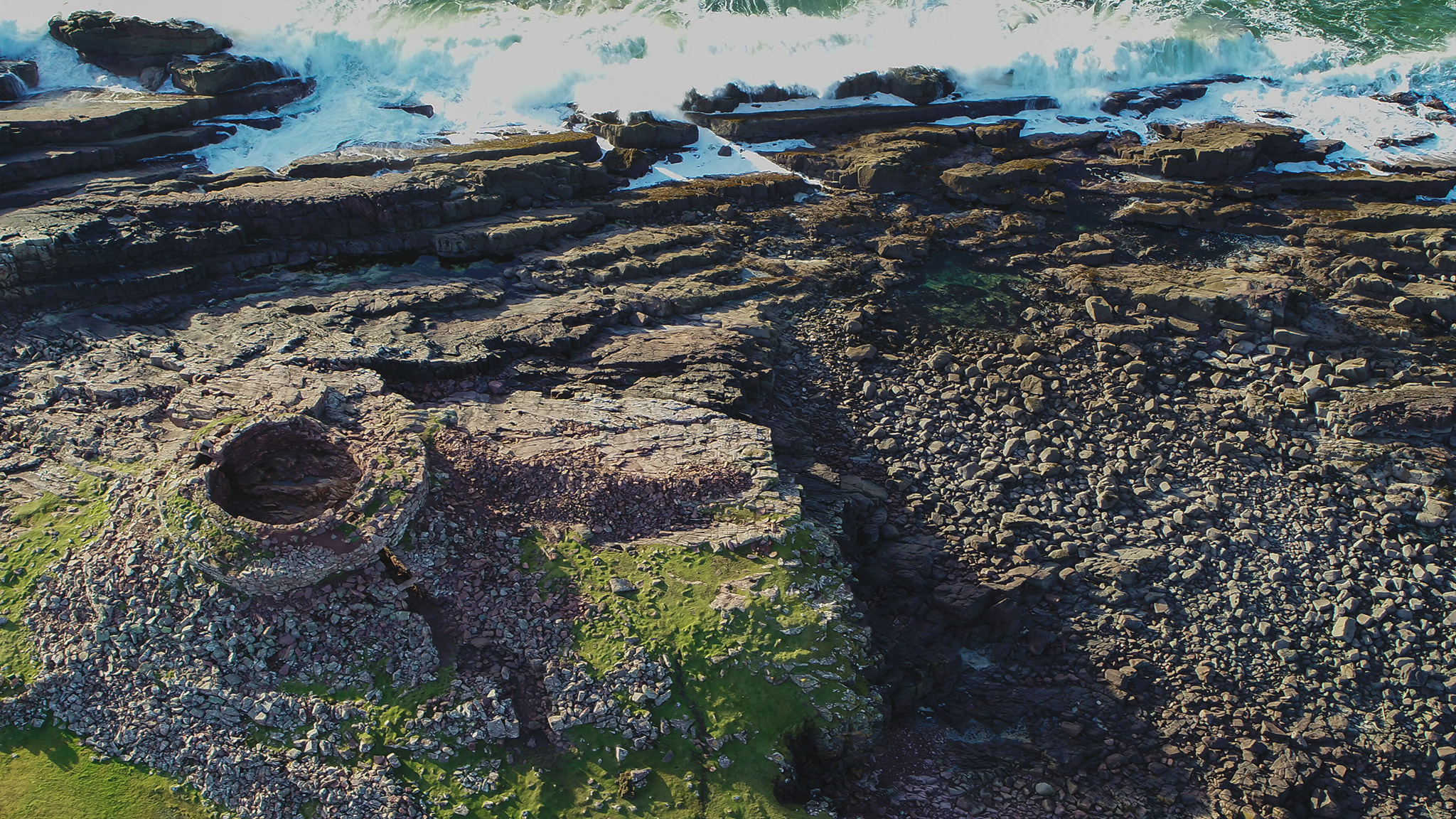Clachtoll Broch stands in an imposing position on Scotland’s west coast. For 2000 years, rubble from the broch’s collapse concealed the remains of this Iron Age home. Excavations by community group Historic Assynt have allowed us to understand how the building functioned.
Mousa Broch, Shetland Isles
Brochs are tall, circular, drystone towers that were built around 2000 years ago, in the Iron Age. They are unique to Scotland, stretching from the far south-west to the northernmost islands. Within the thick walls were small rooms, or cells, and a stairwell provided access to an upper storey. The tallest surviving example is at Mousa, Shetland, standing at around 13m.
__________________________________
The form of a broch’s roof is still much debated but may have been conical and made of thatch or turf, and styles may have varied regionally depending on what was available.
Excavations at Clachtoll have shown that the broch was destroyed in a huge fire in around AD 50. Beneath the rubble from the broch’s collapse were the physical remains of the broch’s last days including hundreds of Iron Age artefacts.
Entrance
The broch is accessed via a low doorway which, like many other brochs, features a distinctive triangular lintel. In the entrance passage, door checks would once have held a sturdy wooden door closed from the inside.
Doorways at either side of the entrance passageway give access to small spaces traditionally known as guard cells, once thought to have been for a sentry to guard the doorway. However, this idea is linked to traditional beliefs that brochs were defensive structures rather than homes, and that Iron Age people were savages. We now understand brochs to have been domestic in nature, and Iron Age people to have been intellectually, socially and emotionally astute.
The cell at the left hand side of the entrance passage at Clachtoll seems to have functioned as a midden space at the time of the fire. The cell at the right hand side was paved and ‘carpeted’ with vegetation, though its function remains elusive.
Clachtoll Broch: entrance with the triangular lintel
Clachtoll Broch: the hearth during excavations
Hearth and home
At the centre of the broch was a large fireplace, a focal point in the circular space. It provided heat for cooking and light for carrying out crafts and tasks, but equally important was its role as a social space where communities would gather to sing, tell stories and make plans (and stay warm through Assynt’s long, cold winter nights, too).
Tread carefully
The broch is built on a rocky knoll which slopes downwards from the seaward side. While deeper crags in the bedrock were filled with rubble to smooth off the floor surface a little, the floor would have been slanted and uneven nonetheless. To counter this, a carpet of sorts was made from vegetation – reeds, rushes and grasses – creating a softer surface. This soft covering was frequently removed and replaced with fresh material, a bit like an Iron Age version of spring cleaning. Happily for our archaeologists, the carpet contained lots of small artefacts, dropped among the rushes and eventually forgotten about.
Archaeologistst excavating the floor at Clachtoll Broch
The stairs at Clachtoll Broch
Stairs
A set of stairs within the wall is one of the defining characteristics of a broch. At Clachtoll, a doorway at the south side of the interior gives access to the stairs, which ascend clockwise. While some brochs stand up to 13m tall, there would have been ample headspace for a multistorey arrangement. However, the form of any upper storeys is much debated. Multiple solid floors, one above the other, are unlikely, not only due to a lack of evidence but because of the need to allow smoke from the ground floor hearth to rise to the roof and seep through the thatch. It seems probable that woven wicker platforms may have provided spaces for storage or for sleeping, perhaps.
Subterranean storage
At the south-eastern side of the interior, a sharp drop in the bedrock was exploited to create a cellar-like space against the broch wall, perhaps covered over with wooden planks or a wicker screen. Other broch sites are known to have underground features like this. Some are interpreted as functional spaces – for storage, perhaps – but it is impossible to rule out a ‘special’ function associated with domestic customs or rituals.
‘Cellar’ - like storage space, similar to Iron Age souterrains
Grain store entrance at Clachtoll Broch
Grain store
Spaces within the wall thickness, known as intramural cells, are a defining feature of brochs. At Clachtoll, a cell to the left of the entrance was accessed via a doorway that sits around 1m above the interior floor surface. On entering the cell, the floor surface is lower still. This suggests that the cell was accessed via a set of steps of ladders.
Analysis of material found within the cell showed that this a storage space for large amounts of grain, both unprocessed sheaves and processed grains. Cereal grains were central to the economy at Clachtoll, and it is possible that the family group who lived here had a prominent role in the wider community, perhaps receiving grain from other local farmers in exchange for kinship or loyalty.











